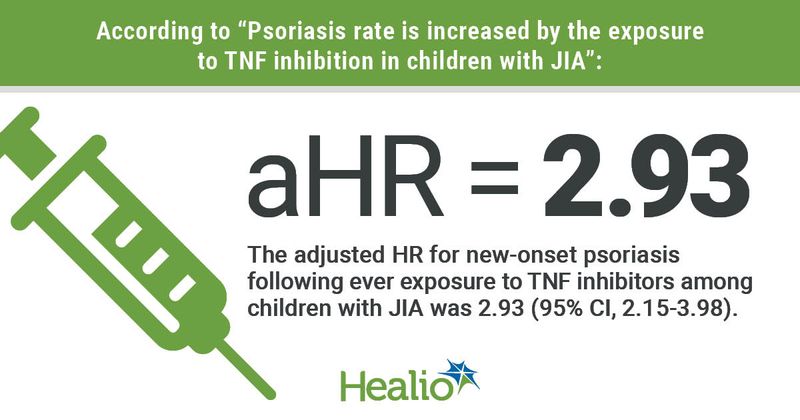TNF inhibitor use in juvenile idiopathic arthritis triples risk for psoriasis
Exposure to TNF inhibitors nearly triples the risk for psoriasis among children with juvenile idiopathic arthritis, according to data published in the Annals of the Rheumatic Diseases.
“Previous studies have reported the increased risk for new-onset of psoriasis in children with JIA, inflammatory bowel disease and non-bacterial osteomyelitis (CNO) from a single Children’s Hospital, as well as a prevalence of nearly 3% in these children from another tertiary children’s hospital,” Yongdong Zhao, MD, PhD, RhMSUS, of the Seattle Children's Research Institute, told Healio.

“However, the association between TNF inhibitors and subsequent psoriasis in JIA has not been systematically assessed using a large prospective clinic-based registry, such as the Childhood Arthritis and Rheumatology Research Alliance (CARRA),” he added. “This large-scale dataset offers the advantage of safety surveillance for pediatric rheumatic medications such as TNF inhibitors.”
To analyze the association between TNF inhibitors and new-onset psoriasis in children with JIA, Zhao and colleagues studied data from the CARRA Registry. According to Zhao, the CARRA Registry features data from more than 10,000 children with rheumatic disease, including more than 9,000 with JIA, across more than 70 sites in North America. The researchers included patients with JIA and follow-up data who were enrolled from June 30, 2015, to Jan. 1, 2020. Those with documented IBD or psoriasis on or before their JIA diagnosis, or with incomplete data, were excluded.

In all, the researchers included 8,225 patients, with a median follow-up of 3.9 years, in their analysis. Among these, 4,437 received TNF inhibitors. Exposure to TNF inhibitors was characterized as either “ever use,” recorded from first use until psoriasis outcome or more recent visit date irrespective of ongoing use or discontinuation; “current use,” recorded from first use and continued for as long as the patient received the drug; or “first use only,” recorded from first use and continues until first use ended.
The researchers determined adjusted HRs between exposed and unexposed groups, adjusting for methotrexate use, sex, race, family history of psoriasis and initial JIA category.
According to the researchers, the adjusted HR for new-onset psoriasis following ever exposure to TNF inhibitors was 2.93 (95% CI, 2.15-3.98). The psoriasis incidence rate was the highest among children who ever received, and were actively receiving, adalimumab (Humira, AbbVie). Meanwhile, ever concurrent MTX use (HR = 0.45; 95% CI, 0.29-0.69) was associated with lower risk for psoriasis.
“We observed a three-fold increased risk for psoriasis in children with JIA after TNF-inhibitor exposure and an adjusted HR of 5.6 in the non-psoriatic arthritis subset,” Zhao said. “There was no association between family history or race/ethnicity and psoriasis development.
“However, concurrent use of methotrexate was significantly associated with a lower risk for psoriasis in those without psoriatic subtype of JIA,” he added. “Clinicians should educate patients and families about potential unwanted side effects while taking medications and inquire about symptoms during regular visits. Concurrent methotrexate use can be considered to lower the risk.”
